Competitive Strategy Essay: PESTEL, SWOT, Porter's Models
VerifiedAdded on 2023/02/01
|7
|1584
|57
Essay
AI Summary
This essay analyzes four key competitive strategy models: PESTEL, SWOT, Porter's Five Forces, and Porter's Generic Strategies. The PESTEL framework is applied to assess Telstra's macro-environment, considering political, economic, social, technological, environmental, and legal factors. SWOT analysis evaluates Telstra's strengths, weaknesses, opportunities, and threats. Porter's Five Forces framework examines competitive rivalry, buyer power, supplier power, threats of substitutes, and new entrants within the Australian telecommunications market. Finally, Porter's Generic Strategies are discussed, highlighting Telstra's combined cost leadership and differentiation approach. Each model is explained with practical applications related to Telstra's business operations and competitive landscape.
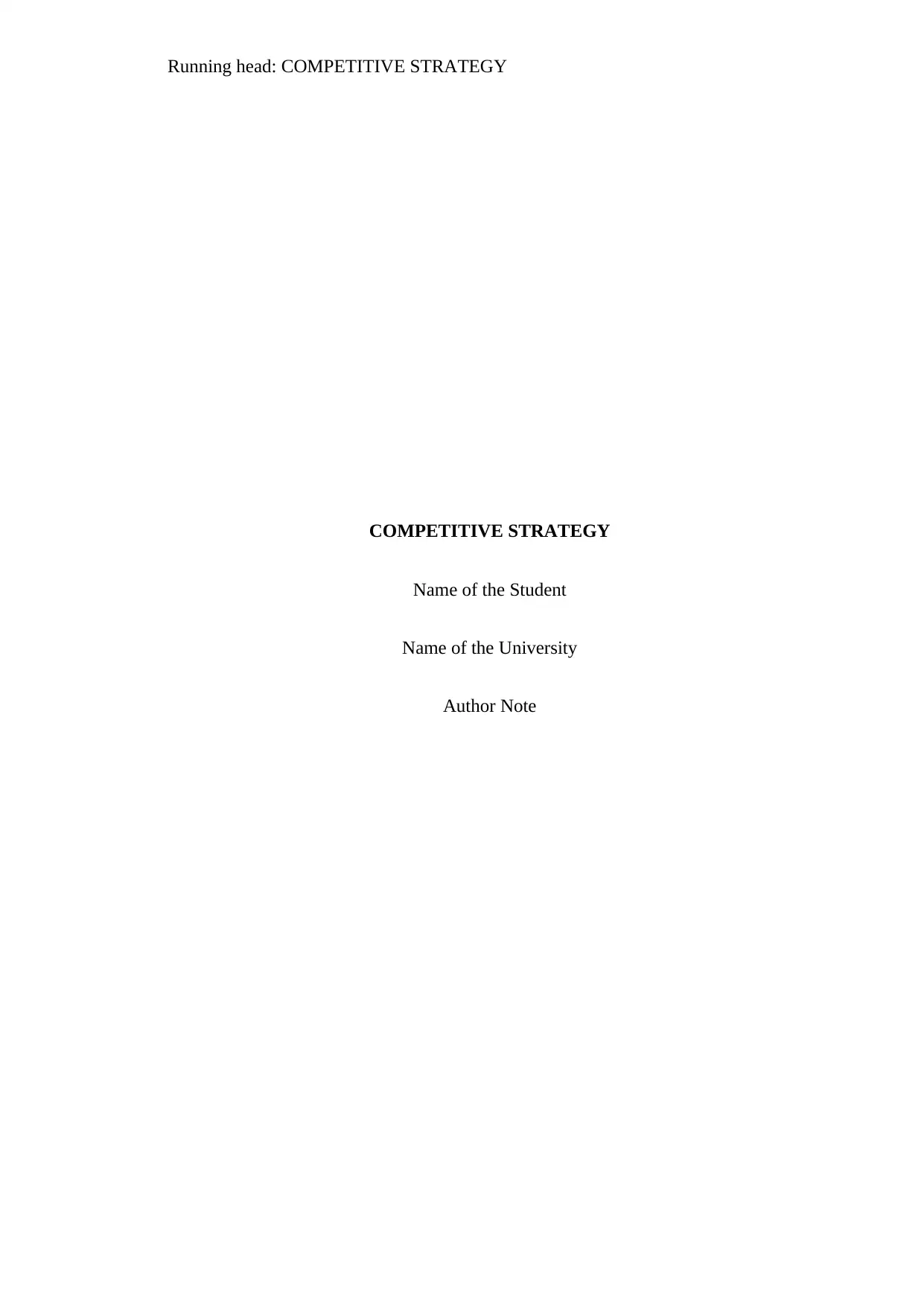
Running head: COMPETITIVE STRATEGY
COMPETITIVE STRATEGY
Name of the Student
Name of the University
Author Note
COMPETITIVE STRATEGY
Name of the Student
Name of the University
Author Note
Paraphrase This Document
Need a fresh take? Get an instant paraphrase of this document with our AI Paraphraser
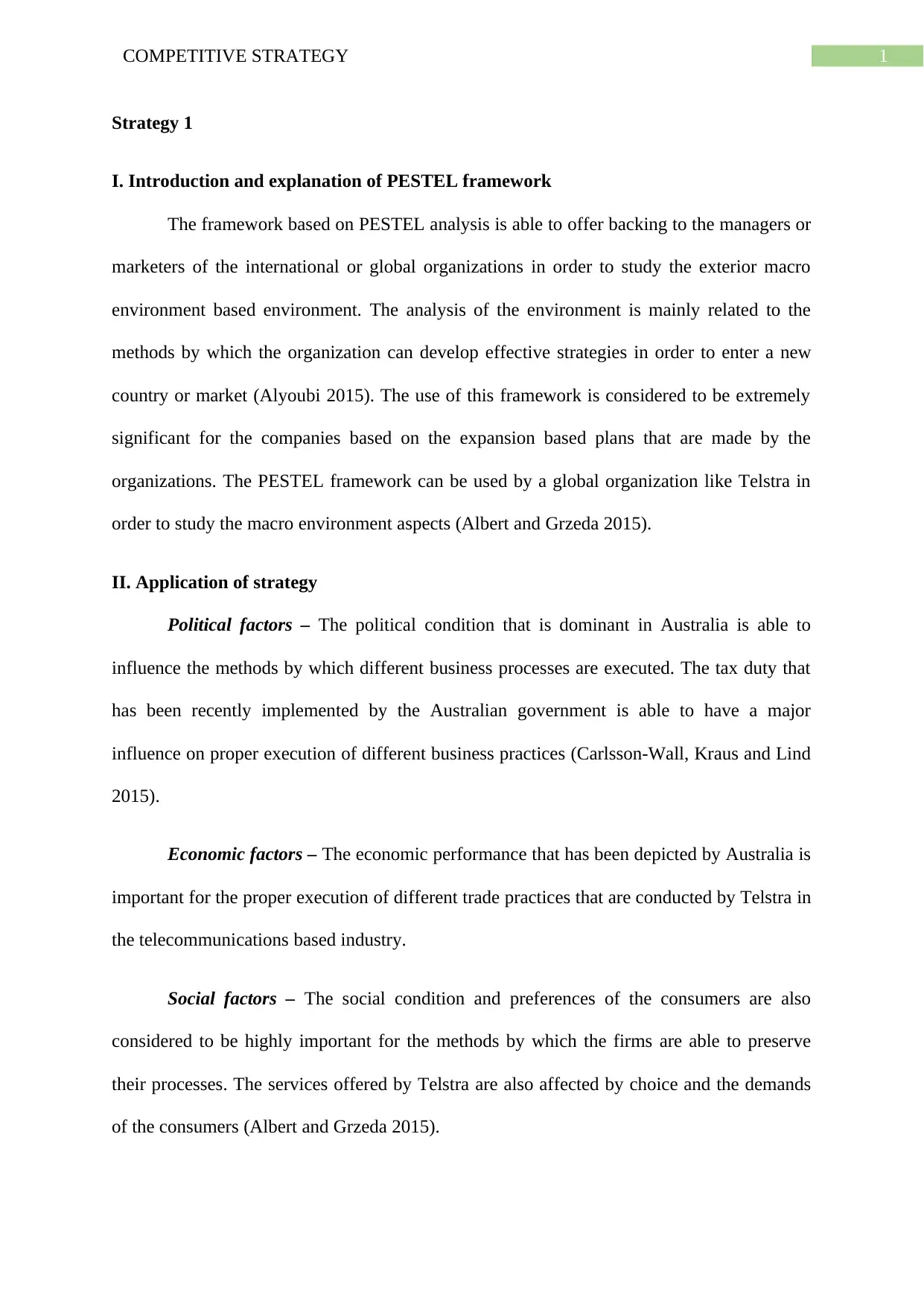
1COMPETITIVE STRATEGY
Strategy 1
I. Introduction and explanation of PESTEL framework
The framework based on PESTEL analysis is able to offer backing to the managers or
marketers of the international or global organizations in order to study the exterior macro
environment based environment. The analysis of the environment is mainly related to the
methods by which the organization can develop effective strategies in order to enter a new
country or market (Alyoubi 2015). The use of this framework is considered to be extremely
significant for the companies based on the expansion based plans that are made by the
organizations. The PESTEL framework can be used by a global organization like Telstra in
order to study the macro environment aspects (Albert and Grzeda 2015).
II. Application of strategy
Political factors – The political condition that is dominant in Australia is able to
influence the methods by which different business processes are executed. The tax duty that
has been recently implemented by the Australian government is able to have a major
influence on proper execution of different business practices (Carlsson-Wall, Kraus and Lind
2015).
Economic factors – The economic performance that has been depicted by Australia is
important for the proper execution of different trade practices that are conducted by Telstra in
the telecommunications based industry.
Social factors – The social condition and preferences of the consumers are also
considered to be highly important for the methods by which the firms are able to preserve
their processes. The services offered by Telstra are also affected by choice and the demands
of the consumers (Albert and Grzeda 2015).
Strategy 1
I. Introduction and explanation of PESTEL framework
The framework based on PESTEL analysis is able to offer backing to the managers or
marketers of the international or global organizations in order to study the exterior macro
environment based environment. The analysis of the environment is mainly related to the
methods by which the organization can develop effective strategies in order to enter a new
country or market (Alyoubi 2015). The use of this framework is considered to be extremely
significant for the companies based on the expansion based plans that are made by the
organizations. The PESTEL framework can be used by a global organization like Telstra in
order to study the macro environment aspects (Albert and Grzeda 2015).
II. Application of strategy
Political factors – The political condition that is dominant in Australia is able to
influence the methods by which different business processes are executed. The tax duty that
has been recently implemented by the Australian government is able to have a major
influence on proper execution of different business practices (Carlsson-Wall, Kraus and Lind
2015).
Economic factors – The economic performance that has been depicted by Australia is
important for the proper execution of different trade practices that are conducted by Telstra in
the telecommunications based industry.
Social factors – The social condition and preferences of the consumers are also
considered to be highly important for the methods by which the firms are able to preserve
their processes. The services offered by Telstra are also affected by choice and the demands
of the consumers (Albert and Grzeda 2015).
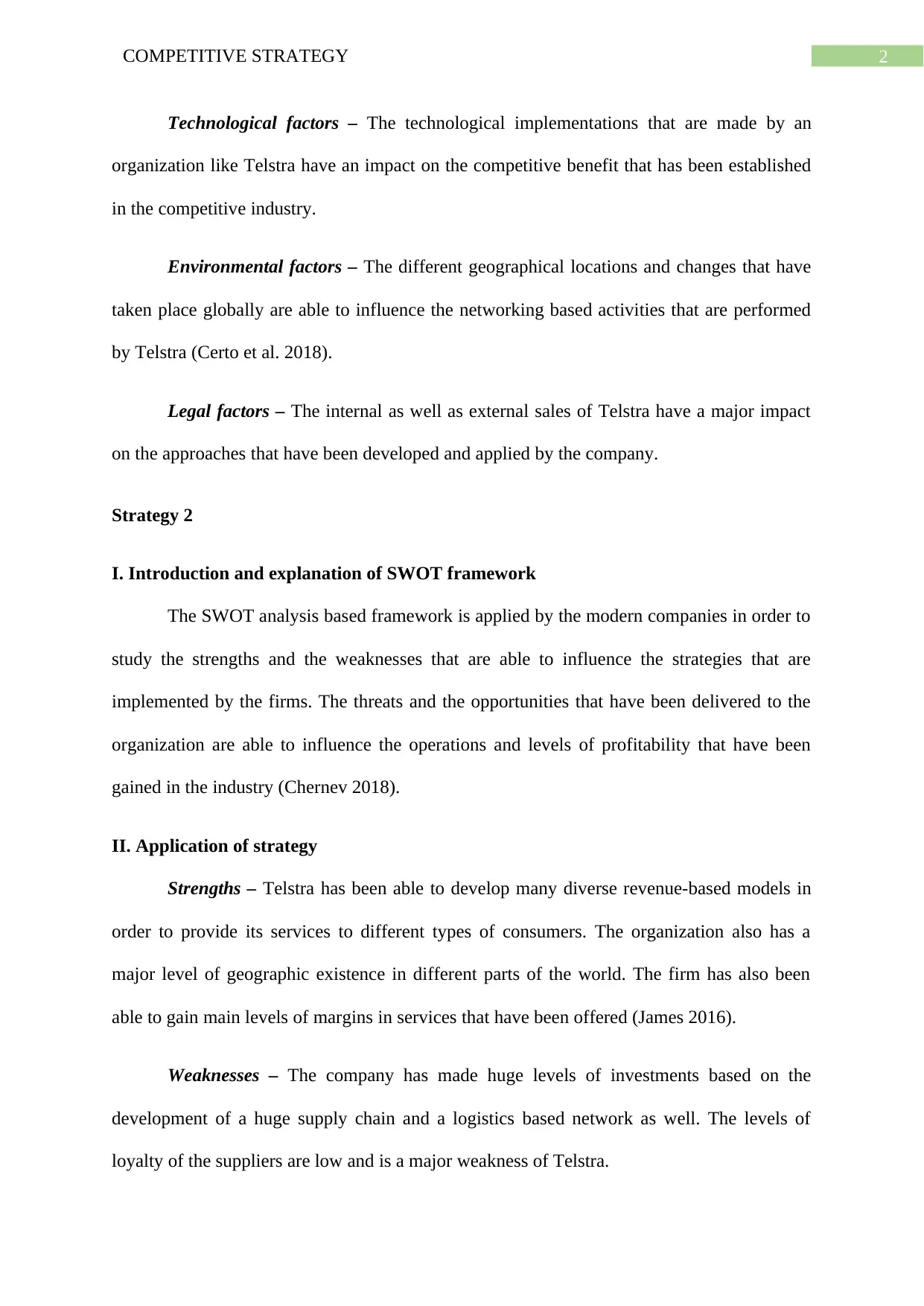
2COMPETITIVE STRATEGY
Technological factors – The technological implementations that are made by an
organization like Telstra have an impact on the competitive benefit that has been established
in the competitive industry.
Environmental factors – The different geographical locations and changes that have
taken place globally are able to influence the networking based activities that are performed
by Telstra (Certo et al. 2018).
Legal factors – The internal as well as external sales of Telstra have a major impact
on the approaches that have been developed and applied by the company.
Strategy 2
I. Introduction and explanation of SWOT framework
The SWOT analysis based framework is applied by the modern companies in order to
study the strengths and the weaknesses that are able to influence the strategies that are
implemented by the firms. The threats and the opportunities that have been delivered to the
organization are able to influence the operations and levels of profitability that have been
gained in the industry (Chernev 2018).
II. Application of strategy
Strengths – Telstra has been able to develop many diverse revenue-based models in
order to provide its services to different types of consumers. The organization also has a
major level of geographic existence in different parts of the world. The firm has also been
able to gain main levels of margins in services that have been offered (James 2016).
Weaknesses – The company has made huge levels of investments based on the
development of a huge supply chain and a logistics based network as well. The levels of
loyalty of the suppliers are low and is a major weakness of Telstra.
Technological factors – The technological implementations that are made by an
organization like Telstra have an impact on the competitive benefit that has been established
in the competitive industry.
Environmental factors – The different geographical locations and changes that have
taken place globally are able to influence the networking based activities that are performed
by Telstra (Certo et al. 2018).
Legal factors – The internal as well as external sales of Telstra have a major impact
on the approaches that have been developed and applied by the company.
Strategy 2
I. Introduction and explanation of SWOT framework
The SWOT analysis based framework is applied by the modern companies in order to
study the strengths and the weaknesses that are able to influence the strategies that are
implemented by the firms. The threats and the opportunities that have been delivered to the
organization are able to influence the operations and levels of profitability that have been
gained in the industry (Chernev 2018).
II. Application of strategy
Strengths – Telstra has been able to develop many diverse revenue-based models in
order to provide its services to different types of consumers. The organization also has a
major level of geographic existence in different parts of the world. The firm has also been
able to gain main levels of margins in services that have been offered (James 2016).
Weaknesses – The company has made huge levels of investments based on the
development of a huge supply chain and a logistics based network as well. The levels of
loyalty of the suppliers are low and is a major weakness of Telstra.
⊘ This is a preview!⊘
Do you want full access?
Subscribe today to unlock all pages.

Trusted by 1+ million students worldwide
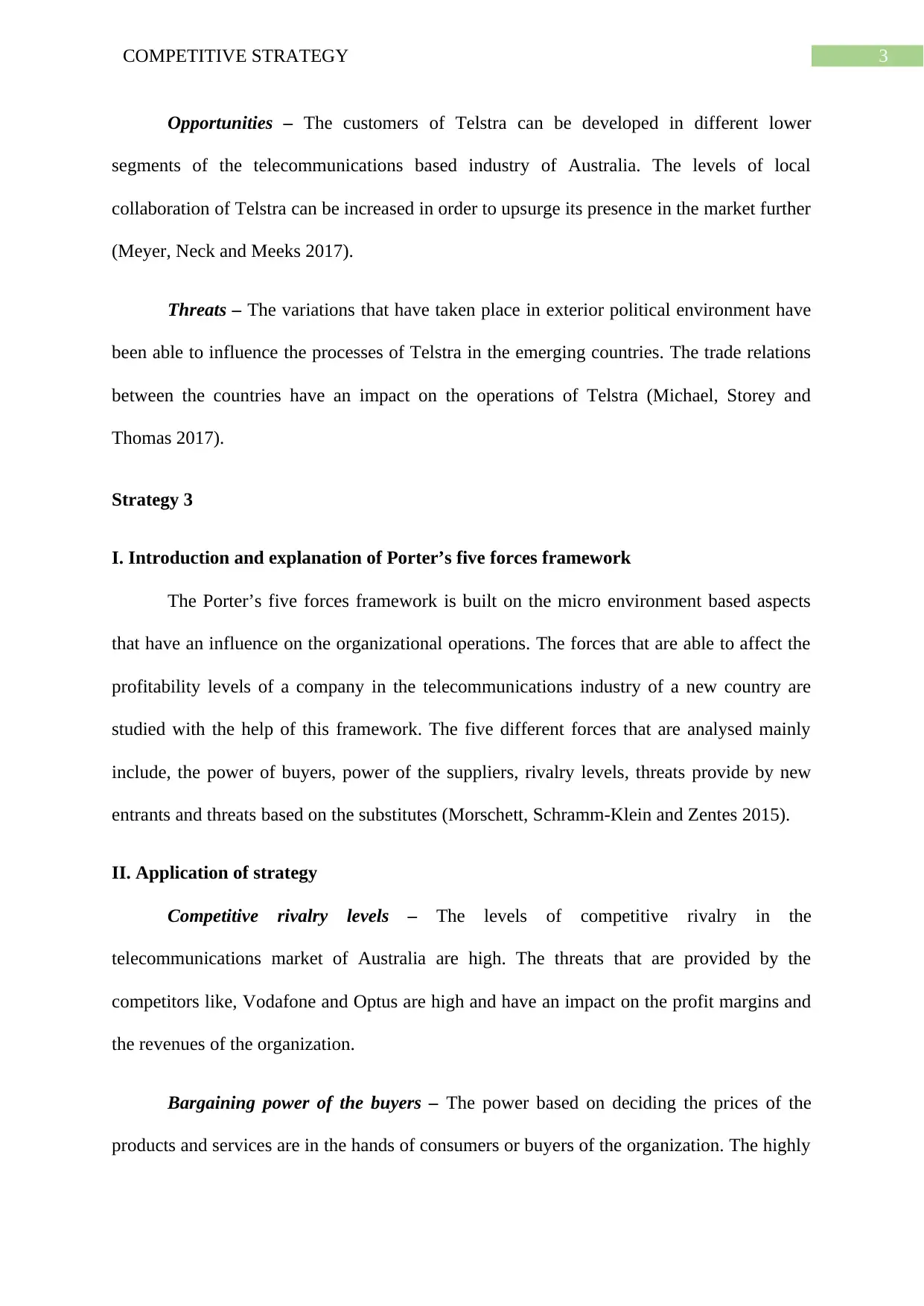
3COMPETITIVE STRATEGY
Opportunities – The customers of Telstra can be developed in different lower
segments of the telecommunications based industry of Australia. The levels of local
collaboration of Telstra can be increased in order to upsurge its presence in the market further
(Meyer, Neck and Meeks 2017).
Threats – The variations that have taken place in exterior political environment have
been able to influence the processes of Telstra in the emerging countries. The trade relations
between the countries have an impact on the operations of Telstra (Michael, Storey and
Thomas 2017).
Strategy 3
I. Introduction and explanation of Porter’s five forces framework
The Porter’s five forces framework is built on the micro environment based aspects
that have an influence on the organizational operations. The forces that are able to affect the
profitability levels of a company in the telecommunications industry of a new country are
studied with the help of this framework. The five different forces that are analysed mainly
include, the power of buyers, power of the suppliers, rivalry levels, threats provide by new
entrants and threats based on the substitutes (Morschett, Schramm-Klein and Zentes 2015).
II. Application of strategy
Competitive rivalry levels – The levels of competitive rivalry in the
telecommunications market of Australia are high. The threats that are provided by the
competitors like, Vodafone and Optus are high and have an impact on the profit margins and
the revenues of the organization.
Bargaining power of the buyers – The power based on deciding the prices of the
products and services are in the hands of consumers or buyers of the organization. The highly
Opportunities – The customers of Telstra can be developed in different lower
segments of the telecommunications based industry of Australia. The levels of local
collaboration of Telstra can be increased in order to upsurge its presence in the market further
(Meyer, Neck and Meeks 2017).
Threats – The variations that have taken place in exterior political environment have
been able to influence the processes of Telstra in the emerging countries. The trade relations
between the countries have an impact on the operations of Telstra (Michael, Storey and
Thomas 2017).
Strategy 3
I. Introduction and explanation of Porter’s five forces framework
The Porter’s five forces framework is built on the micro environment based aspects
that have an influence on the organizational operations. The forces that are able to affect the
profitability levels of a company in the telecommunications industry of a new country are
studied with the help of this framework. The five different forces that are analysed mainly
include, the power of buyers, power of the suppliers, rivalry levels, threats provide by new
entrants and threats based on the substitutes (Morschett, Schramm-Klein and Zentes 2015).
II. Application of strategy
Competitive rivalry levels – The levels of competitive rivalry in the
telecommunications market of Australia are high. The threats that are provided by the
competitors like, Vodafone and Optus are high and have an impact on the profit margins and
the revenues of the organization.
Bargaining power of the buyers – The power based on deciding the prices of the
products and services are in the hands of consumers or buyers of the organization. The highly
Paraphrase This Document
Need a fresh take? Get an instant paraphrase of this document with our AI Paraphraser
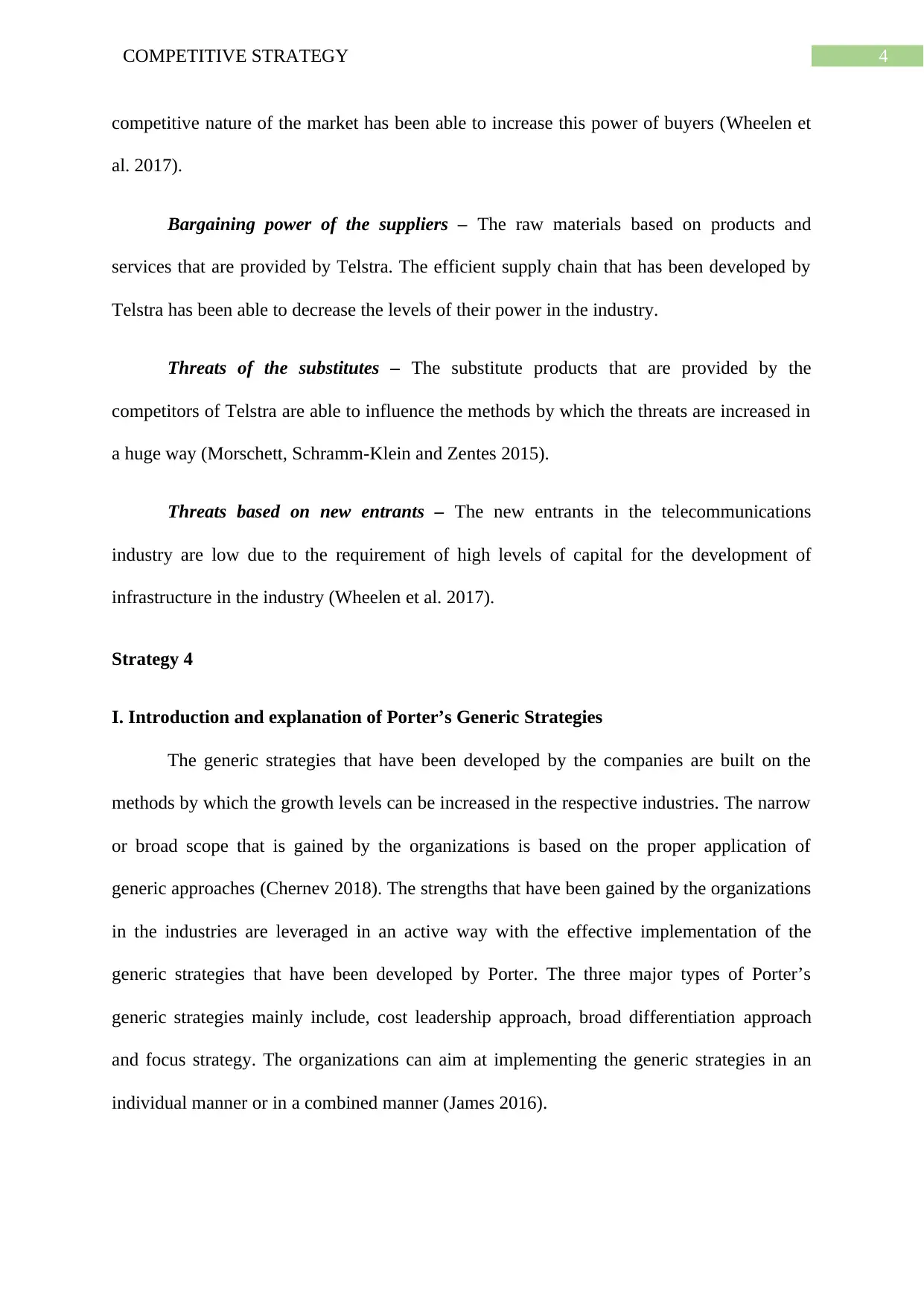
4COMPETITIVE STRATEGY
competitive nature of the market has been able to increase this power of buyers (Wheelen et
al. 2017).
Bargaining power of the suppliers – The raw materials based on products and
services that are provided by Telstra. The efficient supply chain that has been developed by
Telstra has been able to decrease the levels of their power in the industry.
Threats of the substitutes – The substitute products that are provided by the
competitors of Telstra are able to influence the methods by which the threats are increased in
a huge way (Morschett, Schramm-Klein and Zentes 2015).
Threats based on new entrants – The new entrants in the telecommunications
industry are low due to the requirement of high levels of capital for the development of
infrastructure in the industry (Wheelen et al. 2017).
Strategy 4
I. Introduction and explanation of Porter’s Generic Strategies
The generic strategies that have been developed by the companies are built on the
methods by which the growth levels can be increased in the respective industries. The narrow
or broad scope that is gained by the organizations is based on the proper application of
generic approaches (Chernev 2018). The strengths that have been gained by the organizations
in the industries are leveraged in an active way with the effective implementation of the
generic strategies that have been developed by Porter. The three major types of Porter’s
generic strategies mainly include, cost leadership approach, broad differentiation approach
and focus strategy. The organizations can aim at implementing the generic strategies in an
individual manner or in a combined manner (James 2016).
competitive nature of the market has been able to increase this power of buyers (Wheelen et
al. 2017).
Bargaining power of the suppliers – The raw materials based on products and
services that are provided by Telstra. The efficient supply chain that has been developed by
Telstra has been able to decrease the levels of their power in the industry.
Threats of the substitutes – The substitute products that are provided by the
competitors of Telstra are able to influence the methods by which the threats are increased in
a huge way (Morschett, Schramm-Klein and Zentes 2015).
Threats based on new entrants – The new entrants in the telecommunications
industry are low due to the requirement of high levels of capital for the development of
infrastructure in the industry (Wheelen et al. 2017).
Strategy 4
I. Introduction and explanation of Porter’s Generic Strategies
The generic strategies that have been developed by the companies are built on the
methods by which the growth levels can be increased in the respective industries. The narrow
or broad scope that is gained by the organizations is based on the proper application of
generic approaches (Chernev 2018). The strengths that have been gained by the organizations
in the industries are leveraged in an active way with the effective implementation of the
generic strategies that have been developed by Porter. The three major types of Porter’s
generic strategies mainly include, cost leadership approach, broad differentiation approach
and focus strategy. The organizations can aim at implementing the generic strategies in an
individual manner or in a combined manner (James 2016).
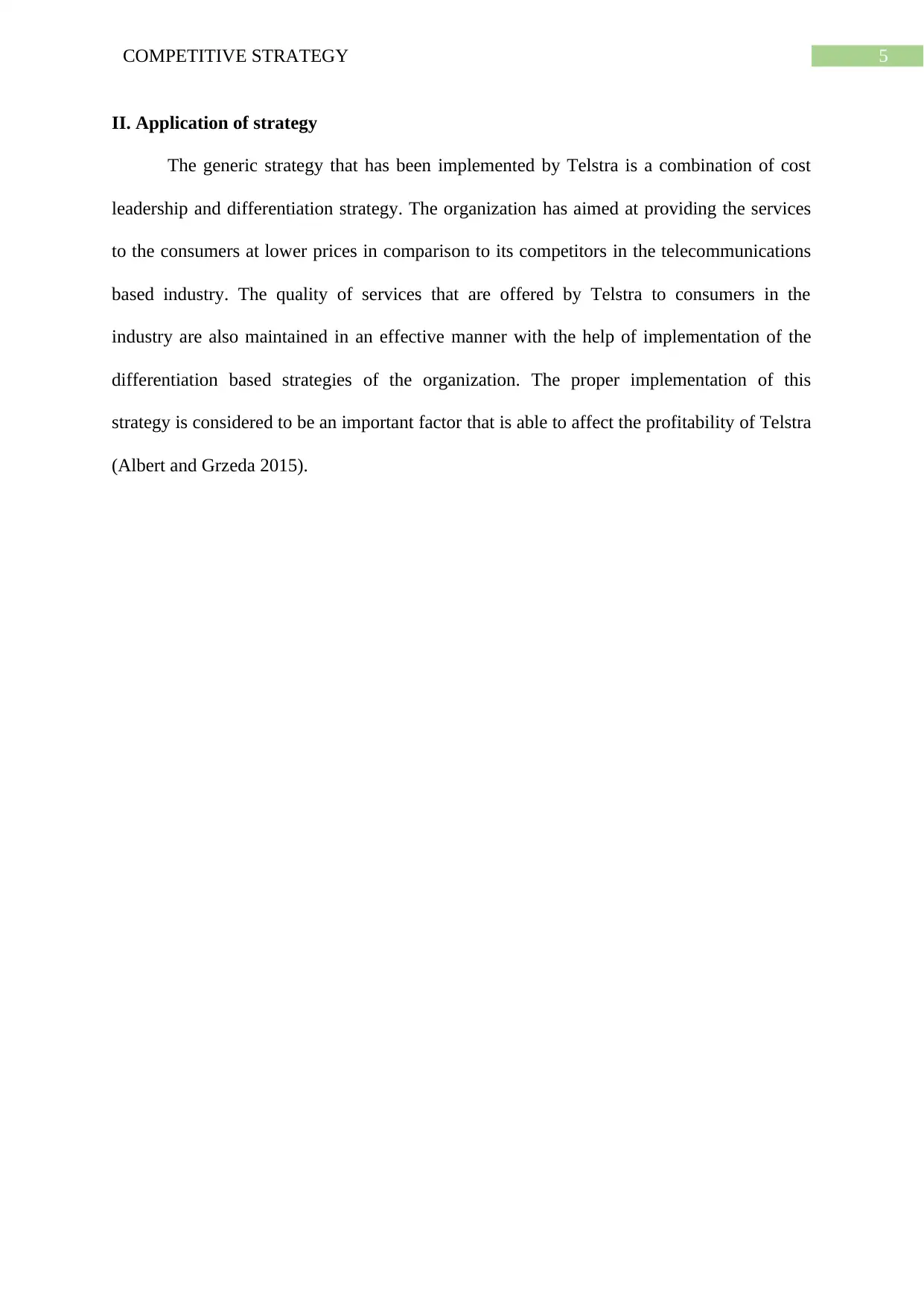
5COMPETITIVE STRATEGY
II. Application of strategy
The generic strategy that has been implemented by Telstra is a combination of cost
leadership and differentiation strategy. The organization has aimed at providing the services
to the consumers at lower prices in comparison to its competitors in the telecommunications
based industry. The quality of services that are offered by Telstra to consumers in the
industry are also maintained in an effective manner with the help of implementation of the
differentiation based strategies of the organization. The proper implementation of this
strategy is considered to be an important factor that is able to affect the profitability of Telstra
(Albert and Grzeda 2015).
II. Application of strategy
The generic strategy that has been implemented by Telstra is a combination of cost
leadership and differentiation strategy. The organization has aimed at providing the services
to the consumers at lower prices in comparison to its competitors in the telecommunications
based industry. The quality of services that are offered by Telstra to consumers in the
industry are also maintained in an effective manner with the help of implementation of the
differentiation based strategies of the organization. The proper implementation of this
strategy is considered to be an important factor that is able to affect the profitability of Telstra
(Albert and Grzeda 2015).
⊘ This is a preview!⊘
Do you want full access?
Subscribe today to unlock all pages.

Trusted by 1+ million students worldwide
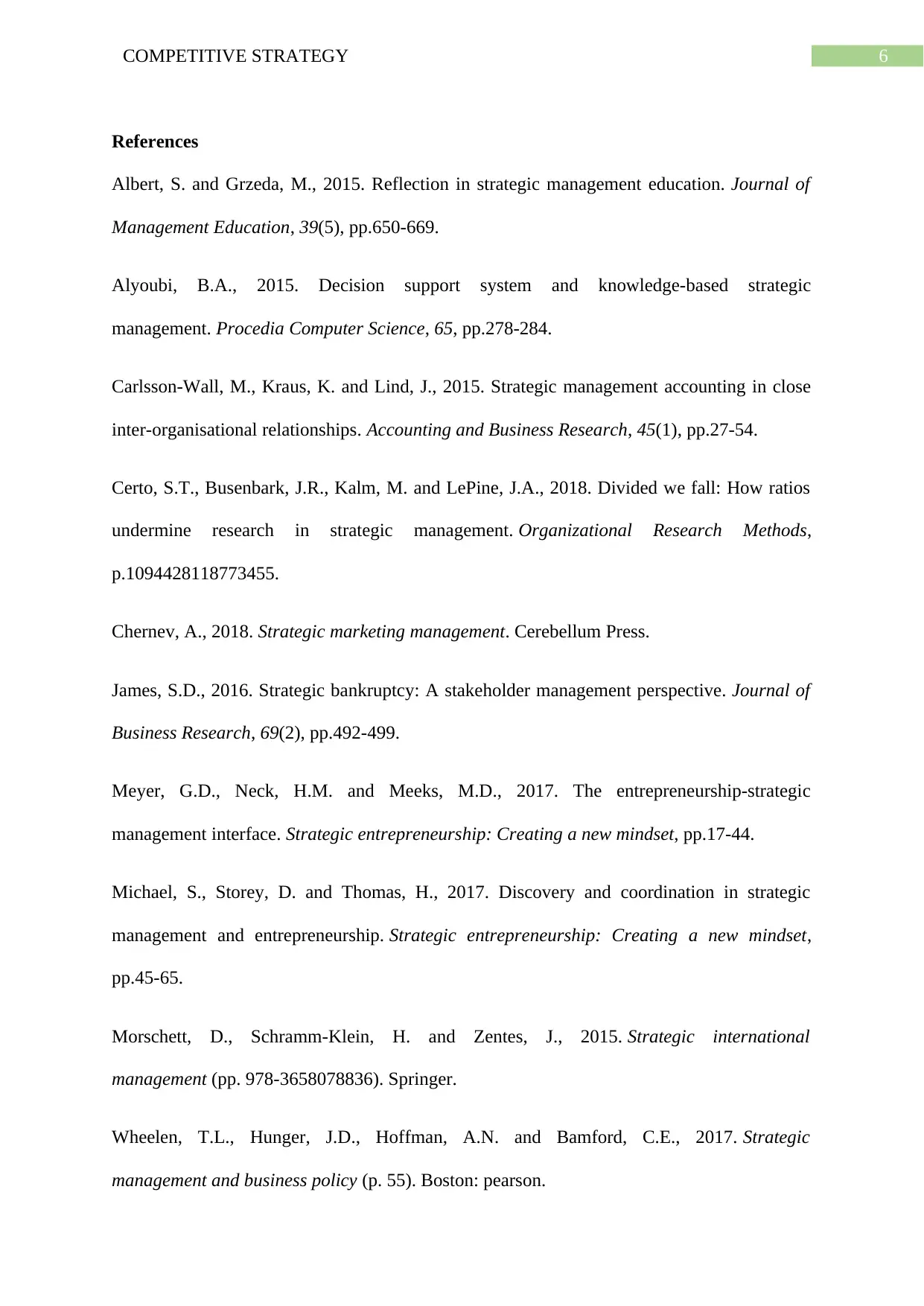
6COMPETITIVE STRATEGY
References
Albert, S. and Grzeda, M., 2015. Reflection in strategic management education. Journal of
Management Education, 39(5), pp.650-669.
Alyoubi, B.A., 2015. Decision support system and knowledge-based strategic
management. Procedia Computer Science, 65, pp.278-284.
Carlsson-Wall, M., Kraus, K. and Lind, J., 2015. Strategic management accounting in close
inter-organisational relationships. Accounting and Business Research, 45(1), pp.27-54.
Certo, S.T., Busenbark, J.R., Kalm, M. and LePine, J.A., 2018. Divided we fall: How ratios
undermine research in strategic management. Organizational Research Methods,
p.1094428118773455.
Chernev, A., 2018. Strategic marketing management. Cerebellum Press.
James, S.D., 2016. Strategic bankruptcy: A stakeholder management perspective. Journal of
Business Research, 69(2), pp.492-499.
Meyer, G.D., Neck, H.M. and Meeks, M.D., 2017. The entrepreneurship‐strategic
management interface. Strategic entrepreneurship: Creating a new mindset, pp.17-44.
Michael, S., Storey, D. and Thomas, H., 2017. Discovery and coordination in strategic
management and entrepreneurship. Strategic entrepreneurship: Creating a new mindset,
pp.45-65.
Morschett, D., Schramm-Klein, H. and Zentes, J., 2015. Strategic international
management (pp. 978-3658078836). Springer.
Wheelen, T.L., Hunger, J.D., Hoffman, A.N. and Bamford, C.E., 2017. Strategic
management and business policy (p. 55). Boston: pearson.
References
Albert, S. and Grzeda, M., 2015. Reflection in strategic management education. Journal of
Management Education, 39(5), pp.650-669.
Alyoubi, B.A., 2015. Decision support system and knowledge-based strategic
management. Procedia Computer Science, 65, pp.278-284.
Carlsson-Wall, M., Kraus, K. and Lind, J., 2015. Strategic management accounting in close
inter-organisational relationships. Accounting and Business Research, 45(1), pp.27-54.
Certo, S.T., Busenbark, J.R., Kalm, M. and LePine, J.A., 2018. Divided we fall: How ratios
undermine research in strategic management. Organizational Research Methods,
p.1094428118773455.
Chernev, A., 2018. Strategic marketing management. Cerebellum Press.
James, S.D., 2016. Strategic bankruptcy: A stakeholder management perspective. Journal of
Business Research, 69(2), pp.492-499.
Meyer, G.D., Neck, H.M. and Meeks, M.D., 2017. The entrepreneurship‐strategic
management interface. Strategic entrepreneurship: Creating a new mindset, pp.17-44.
Michael, S., Storey, D. and Thomas, H., 2017. Discovery and coordination in strategic
management and entrepreneurship. Strategic entrepreneurship: Creating a new mindset,
pp.45-65.
Morschett, D., Schramm-Klein, H. and Zentes, J., 2015. Strategic international
management (pp. 978-3658078836). Springer.
Wheelen, T.L., Hunger, J.D., Hoffman, A.N. and Bamford, C.E., 2017. Strategic
management and business policy (p. 55). Boston: pearson.
1 out of 7
Related Documents
Your All-in-One AI-Powered Toolkit for Academic Success.
+13062052269
info@desklib.com
Available 24*7 on WhatsApp / Email
![[object Object]](/_next/static/media/star-bottom.7253800d.svg)
Unlock your academic potential
Copyright © 2020–2025 A2Z Services. All Rights Reserved. Developed and managed by ZUCOL.




